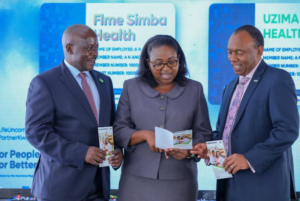Why Multiple, Conflicted Agencies Make A Mess Of Food Safety

By Okisegere Ojepat
Safe food is essential to our health and wellbeing: yet it has emerged as a political football in recent months, as different authorities chase a role in food testing.
That search is now taking a new shape, on the announcement by the Ministry of Health in conjunction with the Ministry of Agriculture of their intention to launch a national food safety agency overseen jointly by the two ministries.
But this is a structure fraught with risk.
For sure, the agencies currently charged with food regulation have been flayed for quality failures, from aflatoxins in maize, poor quality cooking oil, pesticides residue in fruits and vegetables, and antibiotic-filled meats. Yet every government faces these challenges, and the lesson that has been learned globally is that involving multiple agencies in combined and competing agricultural and health oversight causes deaths.
Read: How The Cheap Food Your Employee Is Buying Across The Road Is Ruining Company Performance
Indeed, it was an outlook that was already raising concerns in relation to the embattled bill to launch a Kenyan Food and Drug Administration.
Initially, that bill was to be presented jointly by the Ministries of Health and Agriculture as a government initiative. It was even announced as a fast track bill by the President’s office in December 2018, only to disappear completely, and then be replaced by a private member’s bill without agreement or input from either ministry.
Yet, as the two ministries now announce they are keeping food and drug regulation separate and running food under a single agency, this latest proposal continues to raise an issue that has proven calamitous elsewhere.
That problem lies in defining where along the food chain the Ministry of Agriculture starts and ceases to be responsible for food safety. Recent media commentary has been dominated by issues around pesticide residue. But addressing that issue calls for a clear definition of the two ministries’ responsibilities, and not an amalgamation of these agencies under one.
Read: Medics, Experts Condemn MP’s Move To Remake Kenya’s Food And Medicine Authorities
For instance, produce traceability currently lies under the Ministry of Agriculture, so too do health issues involving animals. Thus, if cases of unsafe meat arise under the new national agency, where would the Ministry of Health step in? At the butcher’s shop, the slaughter house, when animals are being quarantined, at the packaging point, when meat is being transported, at retail outlets?
These are tough questions that need to analysed before a law that aims to save lives ends up costing us deaths instead. For that has been the result of the very same merger of food safety management elsewhere.
In the US, in 2010, two producers recalled more than half a billion eggs after regulators traced salmonella that made nearly 2,000 people sick to unsanitary conditions at two Iowa farms.
At first, it looked like an embarrassing lapse by the US Department of Agriculture (USDA) food safety system, in that it had missed problems in millions of eggs stamped with a USDA grade for quality. But, in fact, regulators hadn’t missed it.
Read: Pharmacists Launch Legislative Review On Food And Drug Regulation
A 2012 report from the Department of Agriculture’s inspector general found officials from the Animal Plant Health Inspection Service (APHIS) were aware the company’s egg-laying barns had tested positive for salmonella over four months before the recall.
An inspector from another agency, the Agricultural Marketing Service (AMS), had also visited the farm two weeks before the recall and observed some of the same sanitation issues. The problem was that the agencies that discovered the health hazards weren’t responsible for overseeing that part of the food safety system and had not passed on what they knew to the agencies that had the authority to act.
As it was, the FDA had jurisdiction over eggs in their shells, but a USDA department was responsible for eggs processed into egg products. APHIS was responsible for ensuring that laying hens didn’t have salmonella, but the feed the hens eat was under FDA control.
Read: Phatisa Food Fund 2 First Closes At US121.5 Million
In a similar tangle of mixed responsibilities, up to 5,000 people died and 325,000 were hospitalised due to foodborne illnesses as the US government recalled 25 million pounds of beef following poor inspections by the FDA.
Such cases finally prompted the US government to announce the disbanding of its FDA and move all its food regulation under the Department of Agriculture.
Tanzania has since taken the same route with its Tanzanian Food and Drug Administration (TFDA). On July 8th 2019, Tanzania’s parliament passed a bill to abolish the TFDA citing the duplication and confusion of roles in food safety as the cause.
This unravelling of food regulation, and placing it under agricultural oversight, reflects the global food safety structure too.
Read: Anzisha Prize Announces Top 20 Young African Entrepreneurs For 2019
The Food and Agriculture Organisation (FAO) manages food safety along the entire value chain, from primary production through processing, distribution, marketing and including nutrition. Indeed, the FAO houses the Codex Secretariat on Food Standards in Rome, which defines the foods fit for human consumption.
The World Health Organisation (WHO), meanwhile, supports food safety through exposure assessments and monitoring of the health impact of food hazards or epidemiological surveillance.
Thus, it will surely benefit Kenyans if the Ministry of Health now moves to support food safety risk assessments through exposure assessment and epidemiological surveillance.
But the Ministry of Agriculture should be left to handle produce safety management across the value chain. It is the ministry that is directly concerned with food production issues. It is in a uniquely informed and expert position, supported by constant engagement levels and the ability to control producers and agricultural markets.
Paramount, however, is that this matter enjoys a sober conversation, without looking like we are fighting an emergency. Thus, we can ensure the strengthening of existing agencies to perform their mandates and better food safety for all of us.
Okisegere Ojepat is the CEO for Fresh Produce Consortium of Kenya
For all the latest technology and business news from Kenya and the world, follow us on Twitter and like us on Facebook







